You should smoke your turkey this Thanksgiving—here's how
It's easier than it sounds.
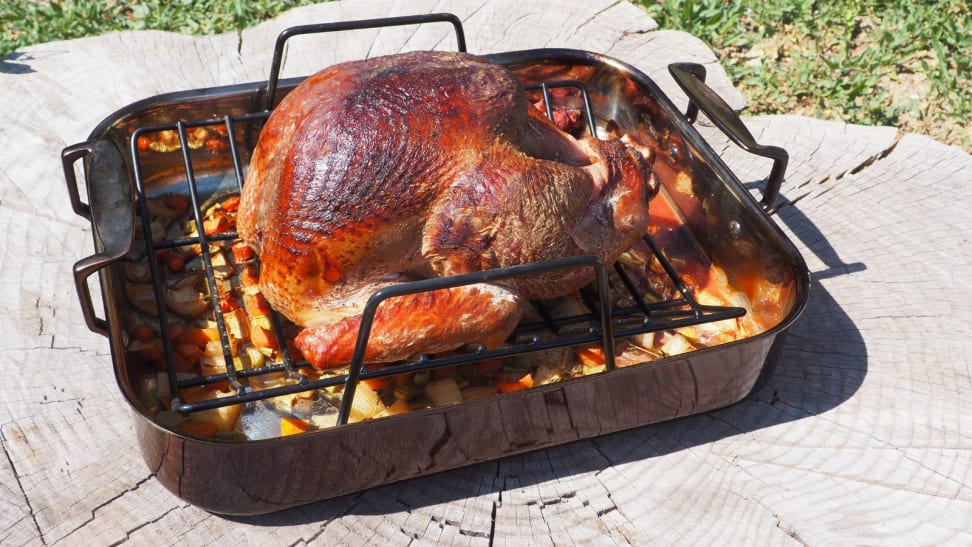 Credit:
Reviewed / Lindsay Mattison
Credit:
Reviewed / Lindsay Mattison
Products are chosen independently by our editors. Purchases made through our links may earn us a commission.
Every year at Thanksgiving, it’s the same: People who normally cook for two to four find themselves preparing a feast for a crowd. It’s not as easy as it sounds, especially for new cooks taking on the turkey cooking challenge for the first time. It’s a little unfair, actually; you’re not only expected to cook a massive 16-pound main dish, but there are all those side dishes and desserts, too. Talk about pressure!
I started thinking there had to be a better way to get it all done and still produce a tasty meal that would (hopefully) impress my family. After spending all summer working with the Big Green Egg, the wheels in my head started turning: What about a smoked turkey? Everything I’d cooked on my new favorite kamado grill tasted fantastic, and it sounded like a real hands-off way to cook a turkey. Plus, it would free up the oven to make roasted vegetables and all my favorite Thanksgiving casseroles, seriously reducing my stress levels on the big day.
To make sure I could pull off this alternative way to cook a turkey, I put the Big Green Egg to the test. I picked up a couple of cups of hickory wood chips, took a few days to thaw the turkey in the refrigerator, and whipped up my favorite dry brine. How did it turn out? Good enough that I might smoke two next time so I end up with leftovers.
How long does it take to smoke a turkey?
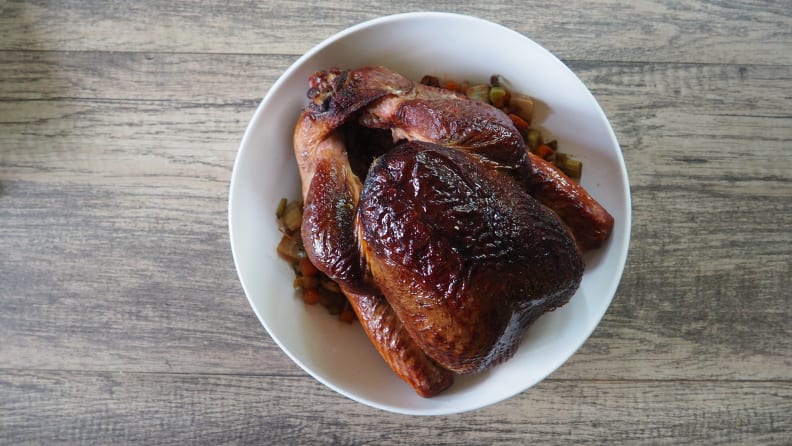
Unlike brisket and pork, turkey doesn't benefit from being cooked low and slow.
First thing’s first: Will it take longer to smoke a turkey than it does to cook it in the oven? Maybe, but not necessarily. We chose to smoke our turkey at 325°F, which is at the higher end of the smoking spectrum. Something like a smoked brisket or pulled pork is usually cooked at lower temperatures like 225°F to 250°F, but that’s not necessary for a turkey. It’s lean without a lot of connective tissue, so it doesn’t require low-and-slow cooking temperatures to break down and become tender.
There is another benefit of smoking at lower temperatures, and it’s prolonged exposure to the smoky environment to infuse extra flavor into the meat. The thing about turkey, though, is that it has a light and delicate flavor. If you cooked it at 250°F, it would take 30 to 40 minutes a pound (or 8 hours for a 16-pound turkey) to cook all the way through. The smoke-forward flavor would completely dominate in a bad way!
Instead, smoking at 325°F only takes 12 minutes a pound, so your 16-pound turkey would be exposed to smoke for three hours only. That’s the perfect amount of time to infuse it with a lightly smoky flavor while keeping the meat inside juicy and moist. Plus, it doesn’t take much longer than cooking a turkey inside in a 350°F oven.
Do you need a smoker to make a smoked turkey?
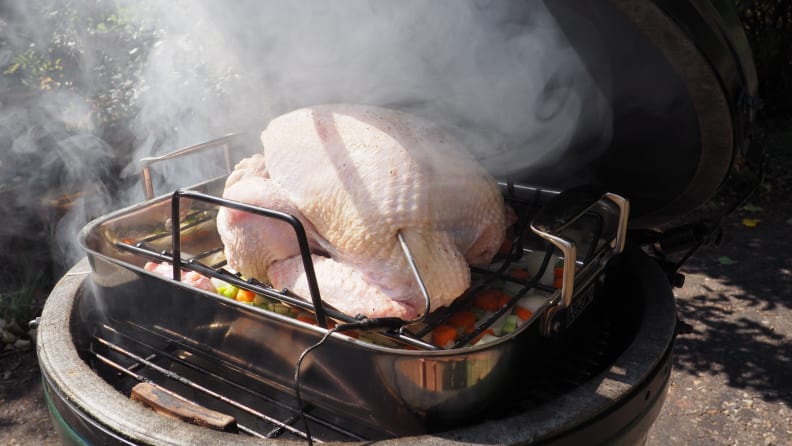
A smoker or kamado grill is great for turkey, but a large normal grill will also work.
If you have a smoker (like our favorite affordable smoker), we definitely recommend using it to smoke a turkey. But, if you don’t have one, you can still make a smoked or grilled turkey. Use a regular gas grill or charcoal grill by igniting half the burners or physically arranging the coals on one half of the grill to set it up for indirect heat. You can add add wood chips to an aluminum foil pouch to create the smoke effect. The only problem with this method is that turkeys are large, and most regular grills aren’t big enough to hold one on half the grill.
A kamado grill solves this problem by using a deflector plate to create indirect heat inside the grill. That means a turkey can take up the entire surface of the grill and still be cooked using indirect heat. Since we happened to have a Big Green Egg on hand, we took the opportunity to put it to the test to see how well this charcoal-powered grill handled a smoked turkey.
Smoking on the Big Green Egg
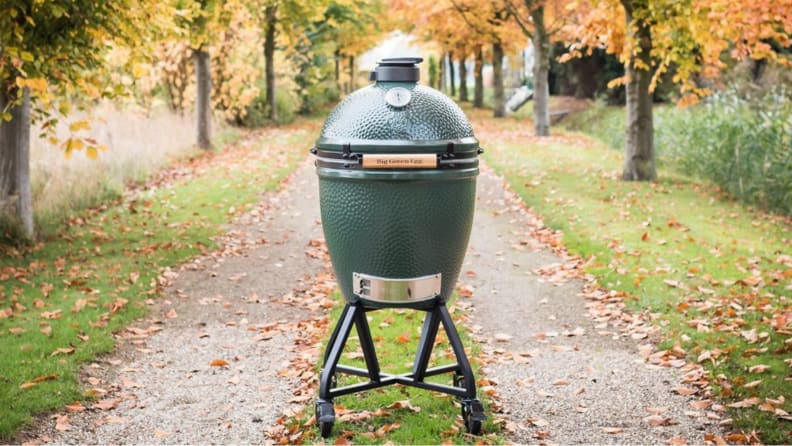
The precise temperature control of the Big Green Egg makes it perfect for smoking.
All in all, we had a fantastic experience smoking on the Big Green Egg. It has better precise temperature control than most charcoal grills, thanks to its thick, insulated ceramic sides and easy-to-use venting system. Simply ignite the lump charcoal and when the coals are ashed over on top, close the lid and slide the bottom vent so it’s mostly closed. This keeps air away from the hot coals, tempering the heat inside to a perfect 325°F.
We will say it was problematic to add additional wood chips or chunks to the coal bed once the ConvEGGtor ceramic deflector plate was in place. That means that once we started the smoking process, we weren’t really able to add any additional wood. What worked for us was interspersing soaked wood chips within the charcoal bed as we built it inside the firebox. That allowed consistent smoke through the cook time, and we didn’t feel the need to add any more during the three-hour smoke.
For the smokiest flavor, we recommend adding a higher proportion of wood chips on top of the charcoal layer—smoke penetrates meat more quickly during the early stages of the cooking cycle.
After the turkey was done, it not only had a really appealing smoke-forward aroma, but it also had a sweet flavor and a beautiful smoke ring. The turkey skin turned a dark mahogany color from the hickory wood chips we added to the firebox, and the dry brine kept the meat extra juicy as the turkey cooked. It freed up the oven and created a better-tasting turkey? Yup, this cooking method is absolutely going to be a staple in our Thanksgiving meal-planning for the next few years.
What you need
Ingredients:
- 1 turkey
- 1 tablespoon baking powder*
- 3 tablespoons kosher salt*
- 3 large yellow onions, chopped
- 2 large carrots, chopped
- 2 stalks celery, chopped
- 2 sprigs thyme
- Freshly ground black pepper
- 2 cups chicken broth, water, or white wine (or a combination)
*These proportions created more than enough dry brine to coat our 16-pound turkey, but you may want to double the recipe if you’re cooking a larger bird.
Tools
- Grill or smoker, like the Big Green Egg
- Propane
- Wood pellets or charcoal, depending on the fuel required by your grill or smoker
- 2 cups of wood chips, like the Wildwood Grilling Smoking Chips Sampler Pack
- Probe thermometer, like the ThermoWorks ChefAlarm
How to smoke a turkey step-by-step
Step 1: Brine the turkey
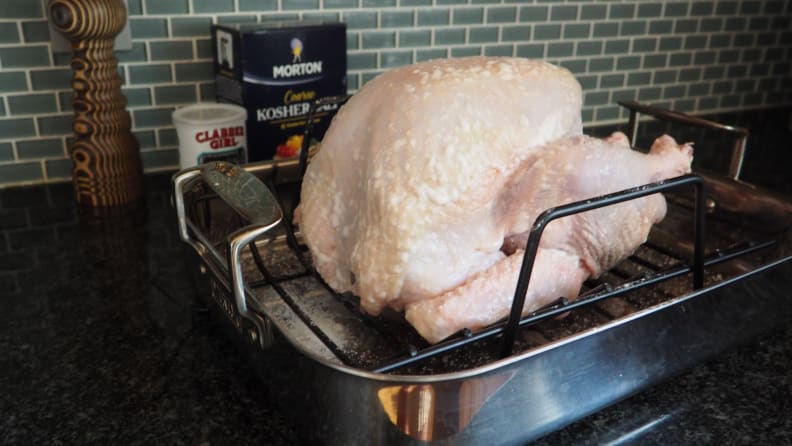
I prefer dry brines to wet brines—they're much less messy and just as effective.
The best way to keep your turkey juicy and moist as it cooks is to brine it. Most recipes use a wet brine (you know, the kind that involves submerging a whole turkey in a salt-and-water solution). This type of brining is such a hassle, so I switched to a dry brine technique a few years ago, and life has never been easier.
Start by placing the turkey in a roasting pan and rub it down with the baking powder and salt mixture. While the baking powder might seem like a weird ingredient, it helps to break down the proteins in the turkey skin so it crisps up and browns while it cooks. Keep in mind that you may not need all the salt mixture, either; just use however much adheres to the outside of the turkey.
Put the salted turkey in the refrigerator, uncovered, and let it marinate for 12 to 24 hours. You can go longer than that if you like, too, but you’ll want to cover it lightly with plastic wrap if you’re brining for longer than 48 hours to prevent the skin from drying out. When you’re ready to cook the bird, there’s no need to rinse off the brine. You can rub the skin with oil and herbs, if you like, but I usually just toss it straight into the smoker, and it tastes great.
Step 2: Prepare the wood chips
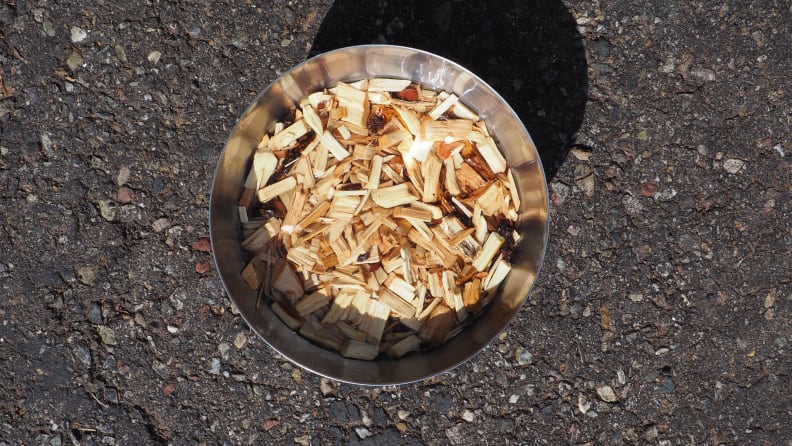
We always recommend soaking your wood chips.
Wood chips need about an hour to soak. This step isn’t completely required—you could just toss them on the smoker straight out of the bag. But soaking them first produces a higher quality smoke because the wet chips will smolder instead of burn. That gives you longer, denser smoke, and you won’t have to reload them into the smoker as many times during the smoking process.
You only need about two cups of wood chips, and you can choose any type of wood you like. We went with hickory because it has a sweet, bacon-like flavor. Fruit woods (like apple or cherry) are also a good choice here, as is pecan.
Step 3: Fire up the smoker
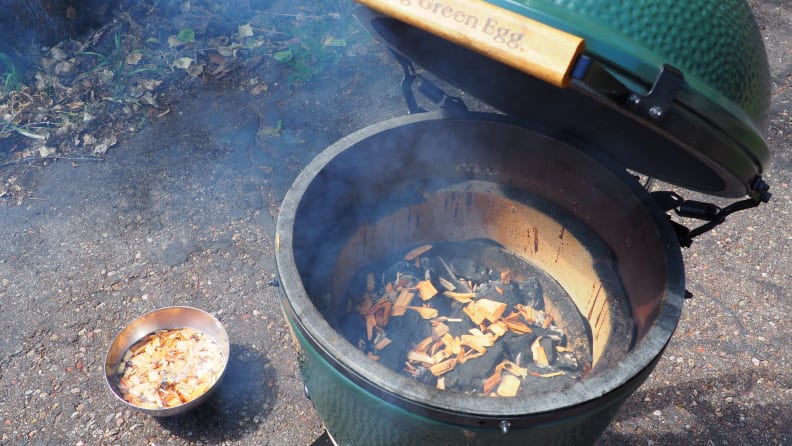
Get your smoker to the desired temperature before adding your turkey.
When your wood chips are ready, it’s time to fire up the smoker. No matter what type of smoker you’re using, make sure you have enough propane, wood pellets, or charcoal to last three to five hours. Or, if you’re working with an electric smoker, an extension cord long enough to make it happen!
In our case, we added lump charcoal to the Big Green Egg and layered the soaked wood chips throughout the coal bed. After using a few starter cubes to get the coals started, we waited until they were hot with a layer of ash over the top. Then, we added the ConvEGGtor to turn the Egg into an indirect-heat smoker, closed the lid, and adjusted the bottom vent to allow just enough air into the grill to maintain a 325°F temperature.
Step 4: Add the turkey
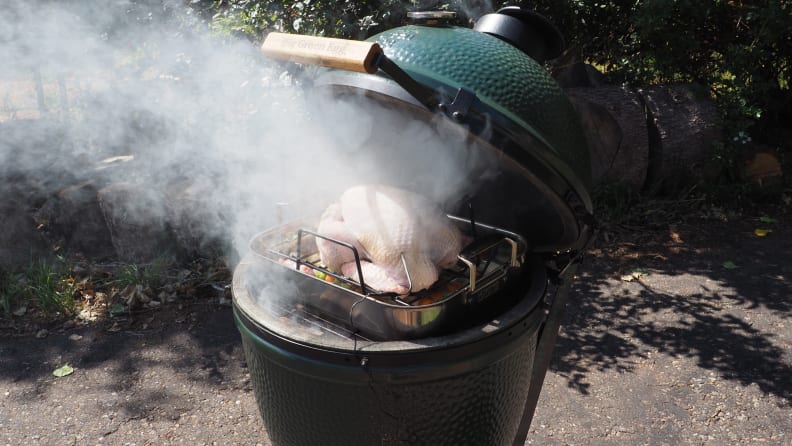
Smoke your turkey in a pan to preserve the juices and reduce clean-up.
If you want to make gravy from the turkey drippings, place the turkey in a large roasting pan (it’s always a good idea to first make sure the pan will fit in the smoker). Add in any optional aromatic ingredients for your gravy, like onion, carrot, and celery. Feel free to add the turkey neck to the pan, too, if you plan to make stock with the turkey carcass later.
If you don’t have a roasting pan, you can use a disposable aluminum pan from the grocery store. Alternatively, you can place the turkey directly on the grill grates. Keep in mind that the latter will create more of a mess, and we never like creating more clean-up than we need to on Thanksgiving!
Finish by inserting a probe thermometer into the thickest part of the breast—close to where the meat joins with the breast bone, but not touching the bone itself. Place the turkey on the smoker and close the lid. When the thermometer reaches 165°F (or 175°F if you’re probing the thigh), the bird is done! At these temperatures, the turkey will take about 12 minutes a pound.
Step 5: Let it rest
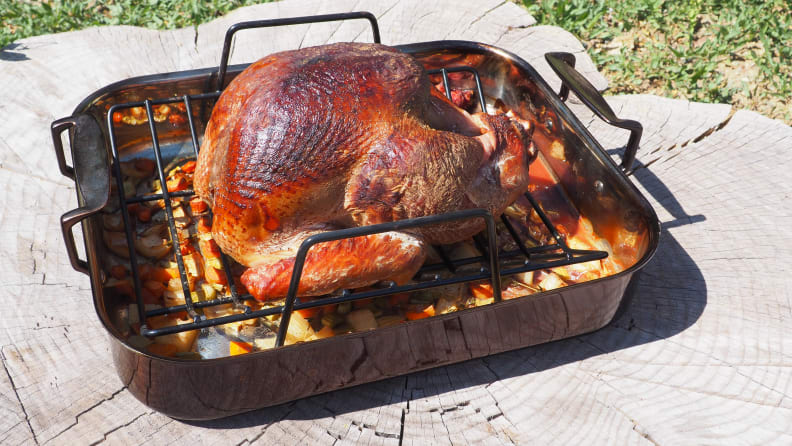
Don't forget to rest your bird—this will let the juices redistribute.
This is the hardest—but most important—part of meat cookery: When the turkey is finished cooking, take it off the smoker and let it rest for at least 30 to 45 minutes before slicing it. If you slice it right away, all those tasty internal juices won’t have the chance to redistribute within the meat and will spill out onto the cutting board. That means a dry, sad turkey, even if you cooked it perfectly.
Resting the meat also gives you an opportunity to make the gravy from the pan drippings! Use a fat separator to discard the excess fat and use the meaty juices to whip up your favorite Thanksgiving gravy recipe.
Step 6: Carve it and enjoy!
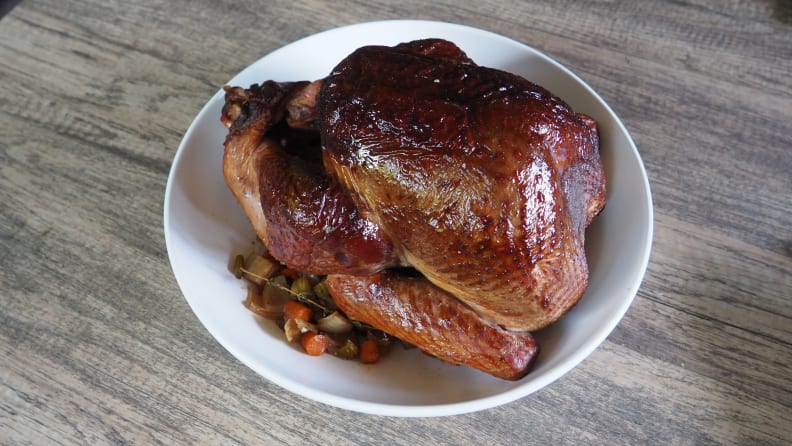
Enjoy your crispy, moist smoked turkey!
From here, carve the turkey using a standard or electric carving knife. It’ll be so sweet and smoky, you won’t be able to resist sneaking a few bites before the platter makes its way to the dinner table. Don’t forget to keep the carcass, too; all that smoke flavor creates an incredible turkey broth.
If you’re sold on smoking your turkey this year, check out the best kamado grill we’ve tested or shop our favorite, the Big Green Egg.
Get the Big Green Egg at Ace Hardware for $979
You’re on your way to becoming a kitchen master. Take the next step and sign up for Chef's Course. You’ll get weekly tips, tricks, and recipes from top chefs sent straight to your inbox. It’s a whole master course for free.


